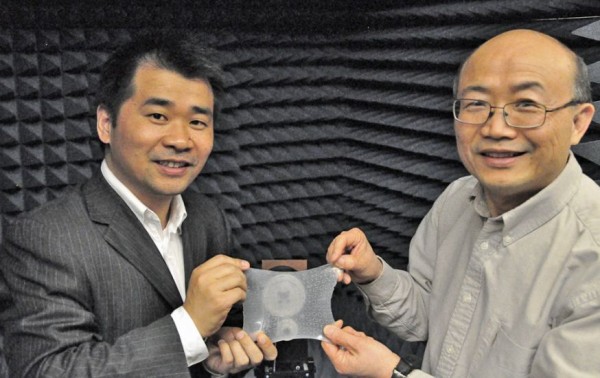‘Meta-skin’ Developed by Iowa State Engineers Can Make Stealth Aircraft Stealthier
| Arthur Dominic Villasanta | | Oct 04, 2016 07:06 AM EDT |
(Photo : Liang Dong) Liang Dong and Jiming Song hold their meta-skin.
(Photo : Liang Dong) Meta-skin close up.
An incredible "meta-skin" that's flexible, stretchable, tunable and can make aircraft stealthier has been developed by a team of Iowa State University engineers.
The "meta-skin" as it's being called uses rows of small, liquid-metal devices to cloak objects from the detection by radar. It was developed by a team of Chinese-American and Chinese researchers.
Like Us on Facebook
The meta-skin takes its name from "metamaterials," which are composites with properties not found in nature but can manipulate electromagnetic waves. The polymer meta-skin can be tuned to reduce the reflection of a wide range of radar frequencies by stretching and flexing it.
The discovery was published online in the journal, Scientific Reports. Lead authors from Iowa State's department of electrical and computer engineering are Liang Dong, associate professor and Jiming Song, professor.
Co-authors are Iowa State graduate students Siming Yang, Peng Liu and Qiugu Wang and former Iowa State undergraduate Mingda Yang. The National Science Foundation and the China Scholarship Council partially supported the project.
"It is believed that the present meta-skin technology will find many applications in electromagnetic frequency tuning, shielding and scattering suppression," said the study.
Dong has a background in fabricating micro and nanoscale devices and working with liquids and polymers. Song has expertise in looking for new applications of electromagnetic waves.
Working together, they were hoping to prove the idea that electromagnetic waves -- perhaps even the shorter wavelengths of visible light -- can be suppressed with flexible, tunable liquid-metal technologies.
What they came up with are rows of split ring resonators embedded inside layers of silicone sheets.
The electric resonators are filled with galinstan, a metal alloy that's liquid at room temperature and less toxic than other liquid metals such as mercury.
Those resonators are small rings with an outer radius of 2.5 millimeters and a thickness of half a millimeter. They have a 1 millimeter gap, essentially creating a small, curved segment of liquid wire.
The rings create electric inductors and the gaps create electric capacitors.
Together they create a resonator that can trap and suppress radar waves at a certain frequency. Stretching the meta-skin changes the size of the liquid metal rings inside and changes the frequency the devices suppress.
Tests showed radar suppression was about 75 percent in the frequency range of 8 to 10 gigahertz, according to the paper. When objects are wrapped in the meta-skin, the radar waves are suppressed in all incident directions and observation angles.
"Therefore, this meta-skin technology is different from traditional stealth technologies that often only reduce the backscattering, i.e., the power reflected back to a probing radar."
As he discussed the technology, Song took a tablet computer and showed a picture of the B-2 stealth bomber. One day, he said, the meta-skin could coat the surface of the next generation of stealth aircraft.
But the researchers are hoping for even more -- a cloak of invisibility.
"The long-term goal is to shrink the size of these devices," Dong said.
"Then hopefully we can do this with higher-frequency electromagnetic waves such as visible or infrared light. While that would require advanced nanomanufacturing technologies and appropriate structural modifications, we think this study proves the concept of frequency tuning and broadening, and multidirectional wave suppression with skin-type metamaterials."
Tagsmeta-skin, iowa state university, metamaterials, Radar, Liang Dong, Jiming Song, electromagnetic waves
©2015 Chinatopix All rights reserved. Do not reproduce without permission
EDITOR'S PICKS
-

Did the Trump administration just announce plans for a trade war with ‘hostile’ China and Russia?
-

US Senate passes Taiwan travel bill slammed by China
-

As Yan Sihong’s family grieves, here are other Chinese students who went missing abroad. Some have never been found
-

Beijing blasts Western critics who ‘smear China’ with the term sharp power
-

China Envoy Seeks to Defuse Tensions With U.S. as a Trade War Brews
-

Singapore's Deputy PM Provides Bitcoin Vote of Confidence Amid China's Blanket Bans
-

China warns investors over risks in overseas virtual currency trading
-

Chinese government most trustworthy: survey
-

Kashima Antlers On Course For Back-To-Back Titles
MOST POPULAR
LATEST NEWS
Zhou Yongkang: China's Former Security Chief Sentenced to Life in Prison

China's former Chief of the Ministry of Public Security, Zhou Yongkang, has been given a life sentence after he was found guilty of abusing his office, bribery and deliberately ... Full Article
TRENDING STORY

China Pork Prices Expected to Stabilize As The Supplies Recover

Elephone P9000 Smartphone is now on Sale on Amazon India

There's a Big Chance Cliffhangers Won't Still Be Resolved When Grey's Anatomy Season 13 Returns

Supreme Court Ruled on Samsung vs Apple Dispute for Patent Infringement

Microsoft Surface Pro 5 Rumors and Release Date: What is the Latest?















